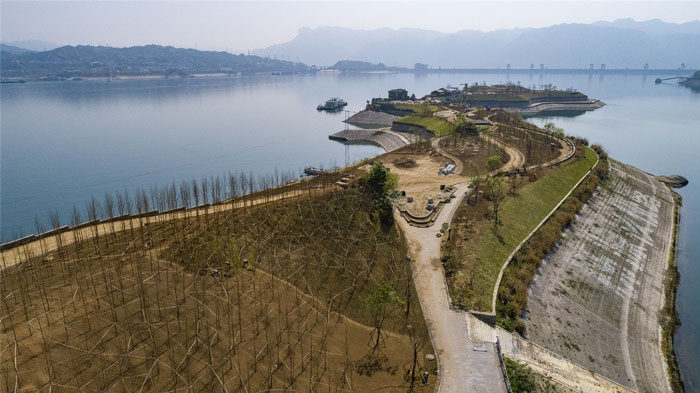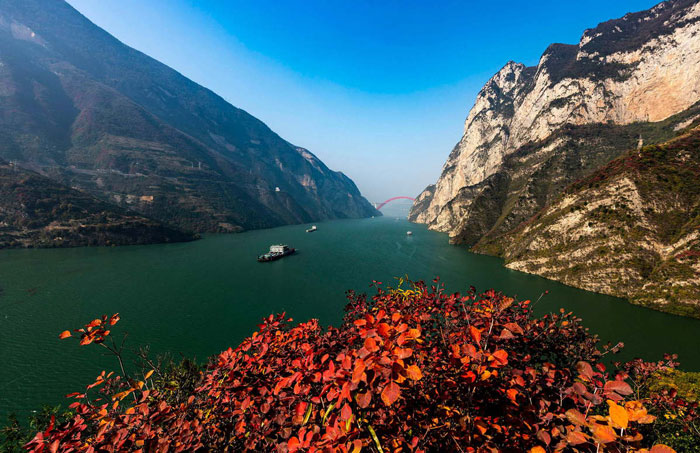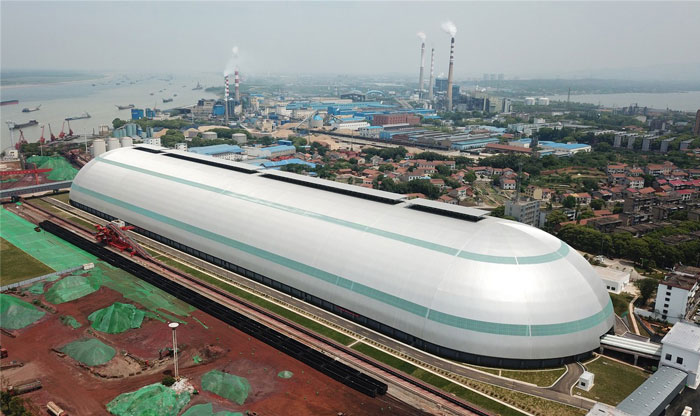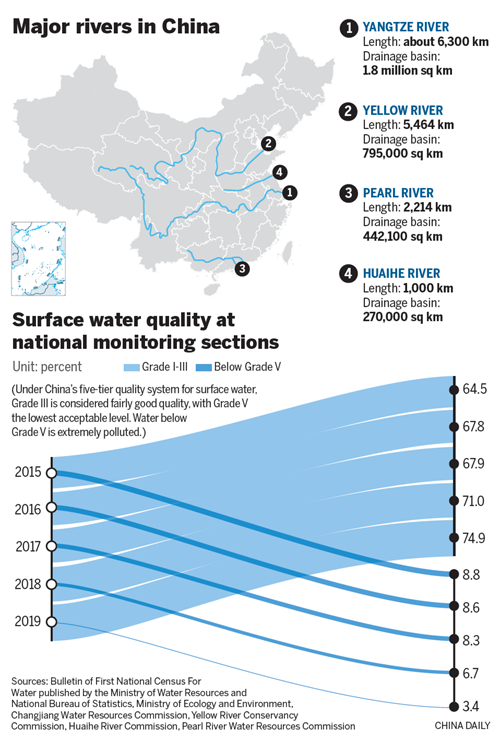
Newsroom
River Protection Efforts Bear Fruit
Xi's thought: Ecology
"Economic development should not be achieved at the cost of the ecology. The ecological environment itself is the economy. Protecting the environment is developing productivity." - President Xi Jinping
Top leadership attaches increasingly greater importance to conservation of Yangtze

Farmers load plums that were just harvested to a vehicle in Wushan county, Chongqing, in June 2018. The county, located in the Three Gorges Dam area, has embarked on the path of ecological development in recent years. WANG QUANCHAO/XINHUA
Xu Dong's colleagues jokingly refer to his cellphone as a hotline because so many people call the researcher at the Institute of Hydrobiology in Wuhan, Hubei province.
Now more often based at the provincial capital's ecology and environment bureau, Xu is part of a team of experts from his institute and seven others that is just one of 58 deployed by the Ministry of Ecology and Environment to major cities in the Yangtze River Economic Belt with the aim of fixing up the river's ecosystem.
As an intermediary facilitating communication between the team and the bureau, he has been busy answering phone calls from both sides.
Xu returns to the institute, an affiliate of the Chinese Academy of Sciences, when the bureau needs its advice on how to address water pollution in Wuhan, which is located in the midstream of the Yangtze River and known for its numerous ponds and lakes.
With China's central leadership attaching increasingly greater importance to conservation of the Yangtze, Asia's longest river, Xu's role is a microcosm of a campaign launched in late 2018 that aims to turn environmental officials and scientists into comrades in arms to remediate the basin's aquatic ecosystem, which was damaged by many years of human activity, including damming, water pollution, overfishing, sand excavation and quarrying.
Some species endemic to the river, such as the baiji dolphin, also known as the Yangtze River dolphin, have not been sighted for years and others are critically endangered. According to the Ministry of Agriculture and Rural Affairs, the annual catch from the Yangtze fell from 427,000 metric tons in 1954 to less than 100,000 tons in recent years.
President Xi Jinping chaired two symposiums about the Yangtze River Economic Belt, in January 2016 and April 2018. At both conferences, he demanded concerted efforts to protect the Yangtze and avoid excessive development.
"We must proceed from the long-term interests of the Chinese nation to put restoring the ecological environment of the Yangtze River at a dominant position, making all-out efforts to protect it, and forbidding large-scale development of the river," he said when presiding over the latest symposium, which was held in Wuhan.
The program Xu and other experts are involved in features both frontline and follow-up research, and the 58 teams in the major cities in the basin had tapped more than 5,000 experts from some 300 institutes by the end of last year, according to the National Joint Research Center for Yangtze River Conservation, established by the Ministry of Ecology and Environment in April 2018.

An aerial view of the construction site of of a bank in the Three Gorges reservoir in Maoping town of Yichang city, Hubei province, April 9, 2020. The project is aimed at enforcing the reservoir bank and improve the ecological environment of the Yangtze River. [Photo/Xinhua]
The joint center is a platform that "effectively integrates scientific research and administrative management", said its head, Li Haisheng.
Many other campaigns are also proceeding, and in the past few years chemical plants near the river have been dismantled or relocated far from it, and illegal ports closed to stop them polluting the river.
In January, a 10-year fishing moratorium began in 332 conservation areas in the Yangtze River Basin to stem the free fall in the river's biodiversity. Ecological problems caused by small hydropower stations were also targeted for rectification in a campaign launched by four ministries in the past year.
A law devoted to Yangtze River conservation was drafted and submitted to national legislators for a first review last year.
Xu said that being an intermediary had contributed a lot to making the mechanism more efficient.
"Once any demands emerge in the bureau, they can always get in touch with me and let me know first," he said. After learning the details, he can return to the institute that day to discuss the issue with Professor Wu Zhenbin, who works there and heads the team in Wuhan. Experts from the eight institutes, who have a range of expertise, could then gather and come up with a preliminary solution the next day, Xu said.
The national joint research center said that by the end of last year, teams it deployed had introduced around 600 treatment technologies and solutions drawn from scientific research to the 58 cities in the Yangtze basin.
The solutions that researchers assigned to the Yangtze protection teams apply to the river's environmental problems yield tailor-made and feasible solutions for its conservation, said Li, who is also president of the Chinese Research Academy of Environmental Sciences.
The Yangtze has seen a continuous improvement in its water quality in recent years. By the end of last year, water from 91.7 percent of monitored sections of the river was at or above Grade III, the third-highest in China's five-tier quality system for surface water, up 4.2 percentage points year-on-year. Water from 0.6 percent of the sections was below Grade V, the lowest quality, down by 1.2 percentage points.
'Mother river'
Other rivers that suffered similar problems during the country's evolution from an agricultural nation to an industrial one are now also seeing their ecosystems restored.
Government data show that 68.9 percent of surface water across the country had a good quality rating-Grade III or above-in 2012, while 10.2 percent was rated below Grade V.

A view of the Yangtze River in Zigui county, Hubei province. [Photo/Xinhua]
Thanks to protection efforts, the share of surface water with a good quality rating rose to 74.9 percent last year, while only 3.4 percent was rated below Grade V.
The improvement was made possible by the importance attached to ecological protection by the top leadership. On many of his inspection tours, Xi has inspected work to protect major local rivers.
Apart from the Yangtze, he has emphasized the importance of ecological protection of the Yellow River, known as China's "mother river". "The protection of the Yellow River is critical to the great rejuvenation and sustainable development of the Chinese nation," Xi said, adding that it is a major national strategy.
Since August 2018, Xi has checked the Yellow River at least four times during inspection tours to various provinces and regions.
In 2016, the general offices of the Communist Party of China Central Committee and the State Council jointly issued a document to implement a river keeper system nationwide. The system, established across the country in 2018, names top local officials as river chiefs and makes them responsible for protecting water resources, controlling and preventing pollution, and restoring aquatic ecosystems.
Seeds of hope
As the national joint center's program and the other campaigns forge ahead, more improvements to the Yangtze's ecosystem are expected.
Yan Zhongning, head of Wuhan's ecology and environment bureau, said dedicated teams, such as the one headed by Wu, are an innovative solution to problems faced by the Yangtze.

Aerial photo taken on April 25, 2020 shows a capsule-shaped bulk cargo warehouse in Yueyang, Central China's Hunan province. Its totally-enclosed feature can effectively avoid the dust pollution previously occurring at the port's freight yard, becoming more beneficial to the eco-environment along the river. [Photo/Xinhua]
"Previously, we looked for experts after we decided to launch certain projects," he said. "We might turn to Professor Wu today and then have no idea which expert we would approach next time. It wasn't systematic at all."
The frequent changes of experts made it hard for individual teams at various institutes to gain a thorough understanding of the conditions of water bodies, which was key to tapping their self-repair potential.
He said the new arrangement could help address the problem. The team's long-term follow-up work on water pollution could help identify major sources of pollutants in different water bodies and aid in the choice of aquatic plants best suited to activate their self-repair.
The novel coronavirus outbreak in Wuhan, the city in China hit hardest by the COVID-19 pandemic, led to the temporary suspension of some of the team's remediation projects, but they found other ways to contribute.
At least 30 team members based in Wuhan helped monitor water bodies around hospitals where COVID-19 patients were being treated, as well as the waste water they discharged. They also conducted research on the effect the widespread use of disinfectants had on the aquatic ecosystem.

Some of the team's demonstration remediation projects resumed on April 1, before the lockdown of Wuhan due to the COVID-19 pandemic was lifted on April 8, and work has now returned to normal.
Xu said restoring the health of water bodies by planting aquatic plants is a complicated undertaking. Plants with a strong ability to resist pollution are usually planted first to improve the water quality so that other less-resistant plants can then survive.
The efforts of his team have borne fruit, with some plants especially suited to ecological remediation that researchers from Wu's institute have planted on a small stretch of water having survived the test of time. (China Daily)